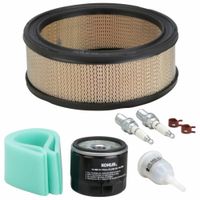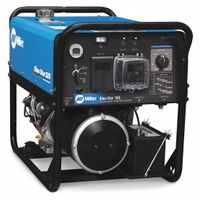Call +(254) 703 030 000 / 751 483 999 / 721 704 777
- Home
- Welding
- Arc Welding
- Engine Driven Welders Accessories
.....Read More
Frequently Asked Questions
What is an engine-driven welder?
An engine-driven welder is a portable welding machine that combines a generator with a welding power source, powered by an internal combustion engine. This type of welder is designed for use in remote locations where access to electricity is limited or unavailable. The engine, typically fueled by gasoline, diesel, or propane, drives the generator, which in turn provides the electrical power necessary for welding operations.
Engine-driven welders are versatile and can perform various welding processes, including Stick (SMAW), MIG (GMAW), TIG (GTAW), and Flux-Cored Arc Welding (FCAW). They are commonly used in construction, pipeline work, maintenance, and repair tasks, as well as in agricultural and industrial settings.
These welders offer several advantages, such as mobility, as they can be easily transported to different job sites. They also provide auxiliary power, allowing them to supply electricity for tools, lights, and other equipment, making them useful in off-grid locations. Additionally, engine-driven welders are built to withstand harsh environments, with robust frames and protective enclosures.
Key features of engine-driven welders include adjustable output settings to accommodate different welding requirements, fuel efficiency for extended operation, and low noise levels for user comfort. Some models also come with advanced technology, such as digital displays and automatic idle control, to enhance performance and ease of use.
Overall, engine-driven welders are essential tools for professionals who require reliable and portable welding solutions in areas without access to conventional power sources.
How does an engine-driven welder work?
An engine-driven welder is a self-contained welding machine that combines a generator with a welding power source, allowing it to operate independently of external power supplies. It is typically powered by an internal combustion engine, which can run on gasoline, diesel, or propane. The engine drives an alternator or generator that produces electricity, which is then converted into the appropriate current and voltage for welding.
The process begins with the engine starting up, which turns the generator. The generator produces alternating current (AC) electricity. This AC power is then transformed into direct current (DC) or modified AC, depending on the welding process required, such as stick, TIG, or MIG welding. The welder can adjust the current and voltage settings to suit the specific welding task.
Engine-driven welders are equipped with control panels that allow operators to select the welding process, adjust the output settings, and monitor the machine's performance. They often include features like idle control, which reduces engine speed when not welding, conserving fuel and reducing noise.
These welders are highly portable and versatile, making them ideal for remote locations or job sites without access to electrical power. They are commonly used in construction, pipeline work, and repair jobs. Additionally, many engine-driven welders can serve as auxiliary power sources, providing electricity for tools and lighting on job sites.
Overall, the engine-driven welder's ability to generate its own power and provide reliable welding capabilities makes it an essential tool for various industrial and field applications.
What are the benefits of using an engine-driven welder?
Engine-driven welders offer several benefits, making them a valuable tool in various welding applications:
1. **Portability**: Engine-driven welders are self-contained units that do not require an external power source, allowing them to be used in remote locations where electricity is unavailable. This makes them ideal for construction sites, pipelines, and field repairs.
2. **Versatility**: These welders can handle multiple welding processes, including Stick, MIG, TIG, and Flux-Cored welding. This versatility allows operators to switch between different welding techniques as needed for various materials and thicknesses.
3. **Power Generation**: In addition to welding, engine-driven welders can function as generators, providing auxiliary power for tools, lights, and other equipment. This dual functionality is particularly useful in off-grid locations.
4. **Durability**: Designed for rugged environments, engine-driven welders are built to withstand harsh conditions, including extreme temperatures, dust, and moisture. This durability ensures reliable performance in challenging settings.
5. **Fuel Options**: These welders can run on various fuels, such as gasoline, diesel, or propane, offering flexibility depending on fuel availability and cost considerations.
6. **Continuous Operation**: With a fuel tank, engine-driven welders can operate continuously for extended periods, unlike electric welders that may be limited by power supply constraints.
7. **Independence from Power Fluctuations**: Engine-driven welders are not affected by power fluctuations or outages, ensuring consistent welding quality and reducing downtime.
8. **Cost-Effectiveness**: While the initial investment may be higher, the ability to perform multiple functions and operate in remote areas can lead to cost savings over time, especially in industries like construction and maintenance.
These benefits make engine-driven welders a practical choice for professionals who require mobility, versatility, and reliability in their welding operations.
What types of welding can be performed with an engine-driven welder?
Engine-driven welders are versatile machines that can perform several types of welding, including:
1. **Shielded Metal Arc Welding (SMAW)**: Also known as stick welding, this is one of the most common types of welding performed with engine-driven welders. It is suitable for outdoor and remote locations due to its simplicity and ability to work in various weather conditions.
2. **Gas Metal Arc Welding (GMAW/MIG)**: Engine-driven welders can perform MIG welding, which is ideal for welding thin to medium-thickness materials. It requires a constant voltage power source and is often used in fabrication and manufacturing.
3. **Flux-Cored Arc Welding (FCAW)**: Similar to MIG welding, FCAW uses a tubular wire filled with flux. It is well-suited for heavy-duty welding tasks and can be performed outdoors, even in windy conditions, making it a good match for engine-driven welders.
4. **Gas Tungsten Arc Welding (GTAW/TIG)**: While less common with engine-driven welders due to the need for a high level of skill and precision, TIG welding can still be performed. It is used for welding thin sections of stainless steel and non-ferrous metals like aluminum.
5. **Submerged Arc Welding (SAW)**: Although not typical for engine-driven welders due to its requirement for a continuous feed of flux, some setups can accommodate SAW for specific applications, especially in fieldwork.
6. **Air Carbon Arc Cutting (CAC-A)**: This process is not welding but is often performed with engine-driven welders. It involves cutting and gouging metals using a carbon electrode and compressed air.
Engine-driven welders are favored in construction, pipeline work, and remote locations due to their portability and ability to generate power independently.
How do I choose the right engine-driven welder for my needs?
To choose the right engine-driven welder, consider the following factors:
1. **Power Output**: Determine the amperage and voltage requirements for your welding tasks. Higher amperage is needed for thicker materials. Ensure the welder can handle the maximum output required for your projects.
2. **Fuel Type**: Decide between gasoline, diesel, or LPG. Gasoline is common and portable, diesel offers better fuel efficiency and is ideal for heavy-duty tasks, while LPG is cleaner and suitable for indoor use.
3. **Duty Cycle**: Check the duty cycle, which indicates how long the welder can operate continuously before needing a rest. A higher duty cycle is better for prolonged use.
4. **Portability**: Consider the weight and size if you need to move the welder frequently. Look for models with wheels or handles for easier transport.
5. **Multi-Process Capability**: If you need versatility, choose a welder that supports multiple processes like MIG, TIG, and Stick welding.
6. **Auxiliary Power**: Some welders provide auxiliary power outlets for running tools or lights. This is useful for remote job sites.
7. **Environment**: Consider the working environment. For outdoor or rugged conditions, choose a welder with a robust build and weather-resistant features.
8. **Noise Level**: If noise is a concern, look for models with quieter operation, especially for residential or noise-sensitive areas.
9. **Brand and Support**: Opt for reputable brands that offer good customer support and warranty. This ensures reliability and access to parts and service.
10. **Budget**: Balance your needs with your budget. While higher-end models offer more features, ensure you’re not overpaying for unnecessary capabilities.
Evaluate these factors based on your specific welding needs to select the most suitable engine-driven welder.
Can engine-driven welders be used as standalone generators?
Yes, engine-driven welders can be used as standalone generators, but there are several considerations to keep in mind. These machines are essentially portable power sources that combine a welding generator with an engine, typically powered by gasoline, diesel, or propane. They are designed primarily for welding tasks, providing the necessary current and voltage for various welding processes. However, many models also come equipped with auxiliary power outlets, allowing them to function as generators for other electrical needs.
When using an engine-driven welder as a generator, it's important to check the specifications of the machine. The auxiliary power output is usually separate from the welding output and is often limited in capacity. This means that while they can power tools, lights, and other equipment, they may not be suitable for high-demand applications or sensitive electronics without additional power conditioning.
The power output is typically measured in watts, and it's crucial to ensure that the total wattage of the devices you plan to power does not exceed the generator's capacity. Additionally, the quality of the power output can vary, with some models providing cleaner power than others. This is particularly important if you intend to power sensitive electronic devices, which may require a more stable power supply.
In summary, while engine-driven welders can serve as generators, their effectiveness and suitability depend on the specific model and the power requirements of the devices you intend to use. Always consult the manufacturer's guidelines and specifications to ensure safe and efficient operation.
What maintenance is required for engine-driven welders?
Engine-driven welders require regular maintenance to ensure optimal performance and longevity. Key maintenance tasks include:
1. **Oil and Filter Changes**: Regularly change the engine oil and oil filter according to the manufacturer's recommendations, typically every 100-200 hours of operation. This helps maintain engine lubrication and prevent wear.
2. **Air Filter Maintenance**: Inspect and clean or replace the air filter regularly to ensure proper air intake and prevent engine strain. This is usually done every 100 hours or more frequently in dusty environments.
3. **Fuel System Care**: Check and clean the fuel filter and lines to prevent clogs. Use fresh, clean fuel and consider adding a fuel stabilizer if the welder is stored for extended periods.
4. **Cooling System Check**: Ensure the cooling system is functioning properly by checking coolant levels and inspecting hoses and the radiator for leaks or blockages. Clean the radiator fins to prevent overheating.
5. **Battery Maintenance**: Inspect battery terminals for corrosion and ensure a secure connection. Keep the battery charged and replace it if it shows signs of weakness.
6. **Spark Plug Inspection**: Check and replace spark plugs as needed to ensure efficient engine starting and operation.
7. **Belt and Hose Inspection**: Regularly inspect belts and hoses for wear, cracks, or damage, and replace them if necessary to prevent breakdowns.
8. **Exhaust System Check**: Inspect the exhaust system for leaks or damage to ensure safe operation and compliance with emissions standards.
9. **Electrical System Maintenance**: Check wiring and connections for signs of wear or corrosion. Ensure all electrical components are functioning correctly.
10. **General Inspection**: Regularly inspect the entire unit for loose bolts, unusual noises, or vibrations, and address any issues promptly.
Following these maintenance steps helps ensure the reliability and efficiency of engine-driven welders, reducing downtime and repair costs. Always refer to the manufacturer's manual for specific maintenance schedules and procedures.

